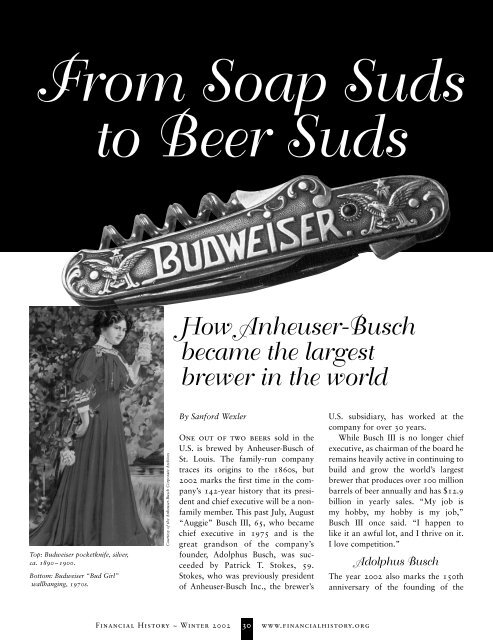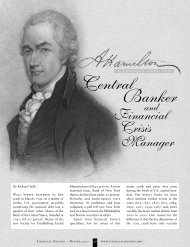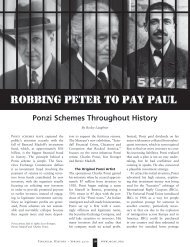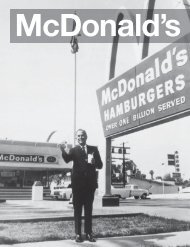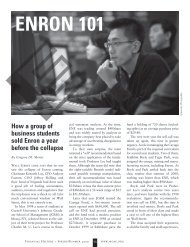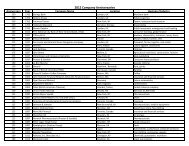From Soap Suds to Beer Suds - Museum of American Finance
From Soap Suds to Beer Suds - Museum of American Finance
From Soap Suds to Beer Suds - Museum of American Finance
You also want an ePaper? Increase the reach of your titles
YUMPU automatically turns print PDFs into web optimized ePapers that Google loves.
<strong>From</strong> <strong>Soap</strong> <strong>Suds</strong><strong>to</strong> <strong>Beer</strong> <strong>Suds</strong>How Anheuser-Buschbecame the largestbrewer in the worldTop: Budweiser pocketknife, silver,ca. 1890 – 1900.Bot<strong>to</strong>m: Budweiser “Bud Girl”wallhanging, 1970s.Courtesy <strong>of</strong> the Anheuser-Busch Corporate ArchivesBy Sanford WexlerOne out <strong>of</strong> two beers sold in theU.S. is brewed by Anheuser-Busch <strong>of</strong>St. Louis. The family-run companytraces its origins <strong>to</strong> the 1860s, but2002 marks the first time in the company’s142-year his<strong>to</strong>ry that its presidentand chief executive will be a nonfamilymember. This past July, August“Auggie” Busch III, 65, who becamechief executive in 1975 and is thegreat grandson <strong>of</strong> the company’sfounder, Adolphus Busch, was succeededby Patrick T. S<strong>to</strong>kes, 59.S<strong>to</strong>kes, who was previously presiden<strong>to</strong>f Anheuser-Busch Inc., the brewer’sU.S. subsidiary, has worked at thecompany for over 30 years.While Busch III is no longer chiefexecutive, as chairman <strong>of</strong> the board heremains heavily active in continuing <strong>to</strong>build and grow the world’s largestbrewer that produces over 100 millionbarrels <strong>of</strong> beer annually and has $12.9billion in yearly sales. “My job ismy hobby, my hobby is my job,”Busch III once said. “I happen <strong>to</strong>like it an awful lot, and I thrive on it.I love competition.”Adolphus BuschThe year 2002 also marks the 150thanniversary <strong>of</strong> the founding <strong>of</strong> theFinancial His<strong>to</strong>ry ~ Winter 200230www.financialhis<strong>to</strong>ry.org
St. Louis brewery where one <strong>of</strong> America’sgreatest business success s<strong>to</strong>riesbegan. The Bavarian Brewery, whicheventually became the Anheuser -Busch brewery, was establishedin 1852 in St. Louis.In 1860, EberhardAnheuser, a prosperousSt. Louis soapand candle manufacturer,invested in thebankrupt brewery.The brewery wasrenamed the E.Anheuser & Co.Bavarian Brewery.Shortly after takingover the failing brewery,Anheuser wasintroduced <strong>to</strong> AdolphusBusch, a 22-year-old Germanimmigrant who rana brewery supply business. Anheuserwas one <strong>of</strong> his cus<strong>to</strong>mers.Busch, the son <strong>of</strong> a wealthymerchant and landowner, arrived inNew Orleans in 1857 with littlemoney and without any home oremployment. What he did have wasbarrels and barrels <strong>of</strong> daring ambition.He traveled up the MississippiRiver and eventually settled in St.Louis, where he found work as a“mud clerk.” Busch inspected steamboatmanifests and sampled cargo.When his father died, Busch drewupon his inheritance <strong>to</strong> establish abrewery supply company. He alreadyknew something about serving uppints <strong>of</strong> beer, as he once workedin a brewery that was partly ownedby his father.The young Busch fell in lovewith one <strong>of</strong> Anheuser’s three unmarrieddaughters. Adolphus Busch andLilly Anheuser were married inMarch <strong>of</strong> 1861. The ceremony was adouble marriage affair <strong>of</strong> whichBusch’s brother, Ulrich, marriedLilly’s sister, Anna.In 1864, following a stint as a corporalin the Union Army during theCivil War, Busch joined his father-inlaw’sbrewery as a salesman. The highlyambitious and enterprising youngBusch would transform the local St.Louis brewery in<strong>to</strong> a thriving nationalbrewery. By 1869,Busch had soldhis brewery supplybusiness and hadbought out theinterest <strong>of</strong> Anheuser’spartner.Busch was now afull partner withhis father-in-law.Top: Adolphus BuschBot<strong>to</strong>m: August A. Busch Jr.For his time, Busch was undoubtedlyan innovative beer promoter. Ashe traveled from tavern <strong>to</strong> tavern, heleft a “calling card” that gave cus<strong>to</strong>mersa memorable and long-lastingimpression <strong>of</strong> his St. Louis brewery. Itwas a small jackknife with the E.Anheuser & Co. logo on the handle.At the end <strong>of</strong> the blade was a tiny picture<strong>of</strong> Adolphus Busch that couldonly be seen by looking througha peephole.“Our business,” Busch repeatedly<strong>to</strong>ld his father-in-law, “is not justmaking beer. No. Making friendsis our business.”Pho<strong>to</strong>s courtesy <strong>of</strong> the Anheuser-Busch Corporate ArchivesBusch was far from satisfied withthe beer that his brewery was turningout. He reportedly called it “dotschlop.” Busch was always on thelookout for ways <strong>to</strong> brew a better tastingbeer. In fact, studying the brewingindustry was his favorite pastime.The Birth <strong>of</strong> BudweiserAround 1875, Busch teamed up with aSt. Louis wine and liquor importer,Carl Conrad, who “discovered” asmooth, light tasting beer that wasproduced at a Bohemian brewery inthe <strong>to</strong>wn <strong>of</strong> Budweis, then part <strong>of</strong>Germany and now in the CzechRepublic. (Today, the <strong>to</strong>wn is calledCeske-Budejovice). In collaborationwith Conrad, Busch developed theformula for a new beer that imitatedthe light beer that was brewed in the<strong>to</strong>wn <strong>of</strong> Budweis. What made thisbrew so unique was its natural carbonation,which was based upon anancient European brewing processcalled kraeusening. The beer is fermenteda second time just when itis beginning <strong>to</strong> age. This brewingprocess results in a distinctive, frothyheadedpale golden beer.In 1876, the beer that wouldbecome the world’s most popularbrand — Budweiser — was introduced.The name Budweiser was coinedby Busch because he felt that despiteits Germanic sounding name, it couldbe easily pronounced by <strong>American</strong>s,and therefore appeal <strong>to</strong> both <strong>American</strong>sand German immigrants. Budweisersoon became the beer <strong>of</strong> choicefor beer drinkers who preferred thelight brew <strong>to</strong> the heavier, sweetbeers that were on the market.Budweiser would ultimately becomeAmerica’s first national beer. At theturn <strong>of</strong> the century, some one millionbarrels <strong>of</strong> Budweiser was beingproduced each year.When Eberhard Anheuser died in1880, Busch became president <strong>of</strong> theSt. Louis brewery, now called theAnheuser-Busch Brewing Association.www.financialhis<strong>to</strong>ry.org 31 Financial His<strong>to</strong>ry ~ Winter 2002
A few years later, Carl Conrad, whowas Busch’s Budweiser partner andalso the bottler and distribu<strong>to</strong>r forAnheuser-Busch, went bankrupt.Busch bought out Conrad’s interestand acquired the trademark rights<strong>to</strong> the beer.Pasteurization& RefrigerationIn the days before pasteurization, beerusually only lasted for a few days.Drawing upon the preservation methodsthat were perfected by LouisPastuer, Busch applied pasteurizationin the brewing process at the St. Louisbrewery. This made it possible forCourtesy <strong>of</strong> the Anheuser-Busch Corporate ArchivesTop: Sponsorship advertisement, “Ken Murray Show,” 1850s.Lower Left: Advertisment, “Life at it’s best,” ca. 1933.Lower Right: Advertisement, “Now…a new car<strong>to</strong>n,” ca. 1936.Budweiser <strong>to</strong> be bottled and distributed<strong>to</strong> beer drinkers way beyond theSt. Louis area. Millions <strong>of</strong> peoplethroughout the country were soonpopping open bottles <strong>of</strong> Budweiser.When artificial refrigeration wasintroduced in the 1880s, Busch <strong>to</strong>okfull advantage <strong>of</strong> this technologicalbreakthrough. Previously, the brewerys<strong>to</strong>red its inven<strong>to</strong>ry in small caves,where the beer was naturally cooledfor three <strong>to</strong> four months before it waspackaged and shipped out. Budweiserbeer was refrigerated in s<strong>to</strong>ck housesat the St. Louis brewery as well as inrailroad cars and in ice houses thatwere located along railroad lines.Courtesy <strong>of</strong> the Anheuser-Busch Corporate ArchivesCourtesy <strong>of</strong> the Anheuser-Busch Corporate ArchivesNationwideMarketing CampaignBesides being the first brewer <strong>to</strong> successfullypreserve and bottle beer,Busch was also the first <strong>to</strong> market beeron a grand scale. The nationwide, promotionalcampaign for Budweiserincluded print and billboard advertisingand a vast array <strong>of</strong> novelty items,such as Anheuser-Busch playing cards,bottle openers, corkscrews, calendars,match boxes, pocket knives, post cards,and various signs and posters.On barroom walls across the country,a poster <strong>of</strong> the attractive “BudweiserGirls” became a familiar sight.The famous, panoramic reproduction<strong>of</strong> the 1876 Little Big Horn massacre,entitled “Custer’s Last Fight,” whichBusch commissioned artist F. Ot<strong>to</strong>Becker <strong>to</strong> paint, was hung on tavernwalls from coast <strong>to</strong> coast. Distributed<strong>to</strong> over a million saloons, it becameone <strong>of</strong> the most recognizable paintingsin the nation.To Busch, marketing <strong>of</strong> bottledbeer was what made his productstand out from all <strong>of</strong> his competi<strong>to</strong>rs.“It is the cream <strong>of</strong> our business,” heonce declared.The vast brewing empire that Buschhad created made him one <strong>of</strong> thenation’s richest men. The young Germanimmigrant who arrived in theU.S. with only a few marks in hispocket lived a lavish lifestyle. He hadseveral homes, including an ornate,Gothic mansion in St. Louis, a countryestate, two palatial homes inPasadena, California, a hop farm inCoopers<strong>to</strong>wn, New York, two villas inLangenschwalbach, Germany, andalso a private railroad car. When hedied at the age <strong>of</strong> 75 in 1913, hiswealth was estimated at some $60million. Adjusted for inflation, Busch’sfortune would equal around $600million <strong>to</strong>day.The Dry YearsAugust A. Busch, Sr., the eldest son <strong>of</strong>Adolphus and Lilly Busch, succeededFinancial His<strong>to</strong>ry ~ Winter 200232www.financialhis<strong>to</strong>ry.org
Events CalendarEvents CalendarWINTER 2003JANUARY24 Guided <strong>to</strong>urs <strong>of</strong> the <strong>American</strong> Numismatic Society’s “Drachmas, Doubloons, and Dollars” exhibit onthe his<strong>to</strong>ry <strong>of</strong> money. Federal Reserve Bank <strong>of</strong> New York, 33 Liberty Street, 1 pm. Call 212-908-4694 for reservations. Free.FEBRUARY26 Lecture and book signing with Willard S. Randall, author <strong>of</strong> Alexander Hamil<strong>to</strong>n, A Life(HarperCollins, January 2003). New York University Stern School <strong>of</strong> Business, 44 West 4th Street,NYC. 7 pm. Free.21 Guided <strong>to</strong>urs <strong>of</strong> the <strong>American</strong> Numismatic Society’s “Drachmas, Doubloons, and Dollars” exhibit,see above.28 “High Notes” exhibit closes.MARCH18 “The Nobel Prize: Celebrating 100 Years <strong>of</strong> Creativity and Innovation” opens in the <strong>Museum</strong>gallery. 28 Broadway, NYC. 212-908-4110.<strong>Soap</strong> <strong>Suds</strong> <strong>to</strong> <strong>Beer</strong> <strong>Suds</strong>continued from page 33in<strong>to</strong> family entertainment arenas, sucha Busch Gardens in Tampa, Florida. In1989, it further expanded in the lucrative,theme park industry with thepurchase <strong>of</strong> SeaWorld.August A. Busch III:Quality Comes FirstAugust A. Busch, III, the great grandson<strong>of</strong> the company’s founder, succeededhis father, Busch, Jr., as chiefexecutive <strong>of</strong> the company in 1975.He had his first swig <strong>of</strong> Budweisersoon after he was born. “The firstthing I ever tasted, before mother’smilk, was beer,” he <strong>to</strong>ld The LosAngeles Times. “It was five drops <strong>of</strong>Budweiser from an eye dropper whenI was five hours old.”Like his father, he literally workedhis way up from the ground floor.He swept floors and cleaned beer tanksin the St. Louis brewery. “When youfinished a shift there,” he <strong>to</strong>ld Fortunemagazine, “you knew you were a man.”Aggressive growth and strategicmarketing is the hallmark <strong>of</strong> BuschIII’s remarkable legacy. In the age <strong>of</strong>market segmentation, he reinventedAdolphus Busch’s credo: “Makingfriends is our business.” The brewerexpanded its affiliation with a vastarray <strong>of</strong> sporting events, includingbaseball, football, basketball, boxing,hockey, golf, tennis, soccer, fishing,sailing, rugby, au<strong>to</strong> racing, jogging,and even round-the-world ballooning.Busch III set his sights far beyondthe borders <strong>of</strong> the U.S. He successfullyestablished a global presence. Today,Anheuser-Busch has breweries in theUnited Kingdom and China andlicenses the production <strong>of</strong> Budweiserin Canada, South America, Europe,and Asia. FHSanford Wexler is a New York-basedfreelance writer. He is the author<strong>of</strong> The Civil Rights Movement: AnEyewitness His<strong>to</strong>ry and WestwardExpansion: An Eyewitness His<strong>to</strong>ry.Both books are published by Facts OnFile. He can be reached at Sanford-Wexler@hotmail.com.SourcesCancelada, Gregory. “Busch III Retires asIndustry Giant after Building Brewerin<strong>to</strong> Behemoth.” St. Louis Post-Dispatch,June 30, 2002.“King <strong>of</strong> Bottled <strong>Beer</strong>,” Fortune, July 1935.Martin, Wilbur. “Here Comes the King —<strong>of</strong> the <strong>Beer</strong> Business,” Nation’s Business,November 1978. Vol. 66, No. 11;pgs. 66 –73.O’Hanlon, Thomas. “August Busch BrewsUp a New Spirit in St. Louis.” Fortune,January 15, 1979.Plavchan, Ronald Jan. A His<strong>to</strong>ry <strong>of</strong>Anheuser-Busch, 1852 – 1933. ArnoPress: New York, 1976.Welles, Chris. “Anheuser-Busch: ToughApproach Made it King <strong>of</strong> <strong>Beer</strong>.” LosAngeles Times, December 15, 1985.www.financialhis<strong>to</strong>ry.org 37 Financial His<strong>to</strong>ry ~ Winter 2002


